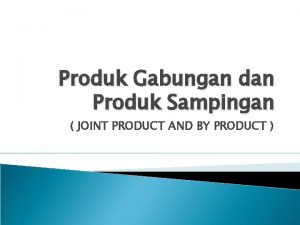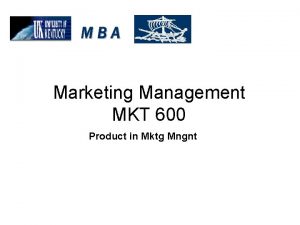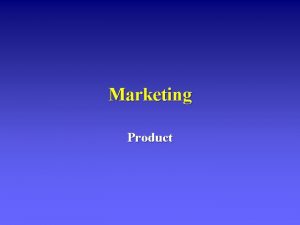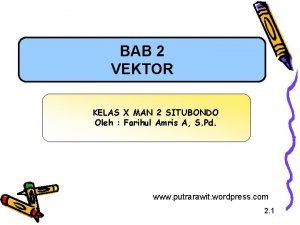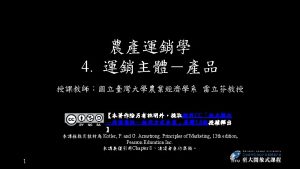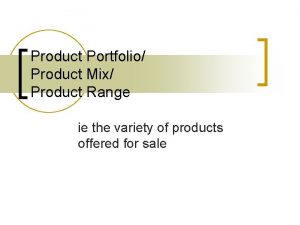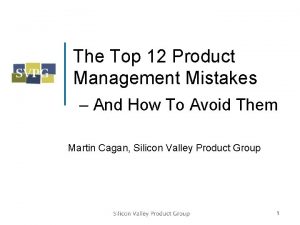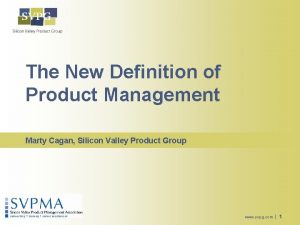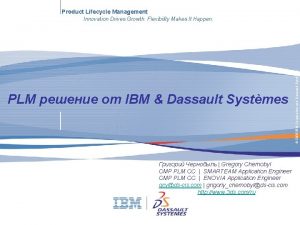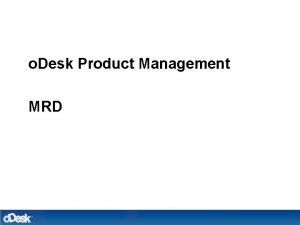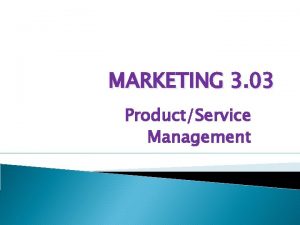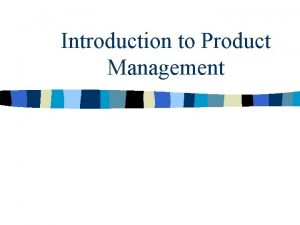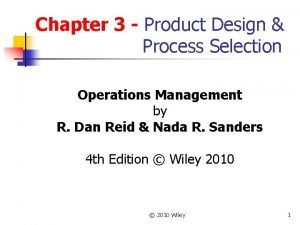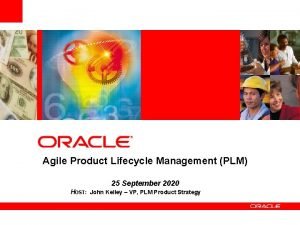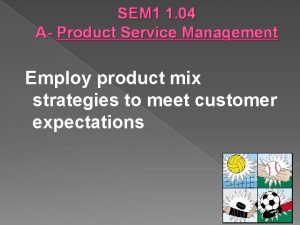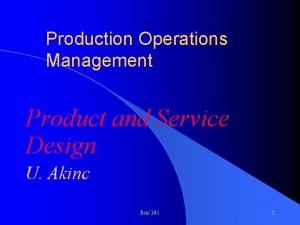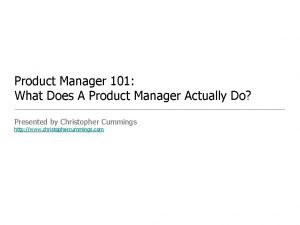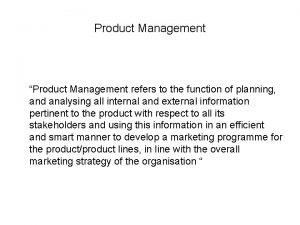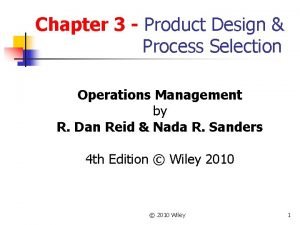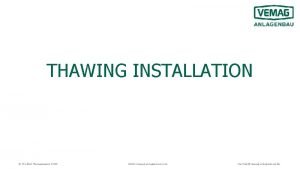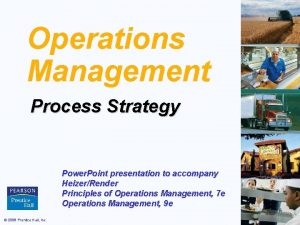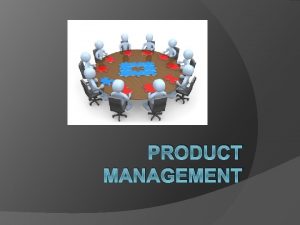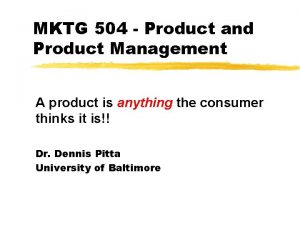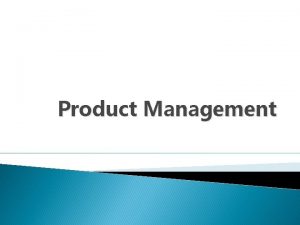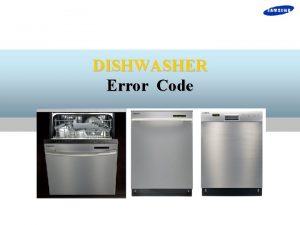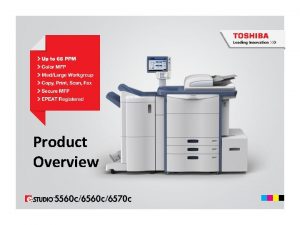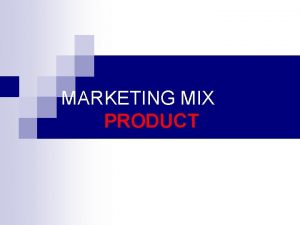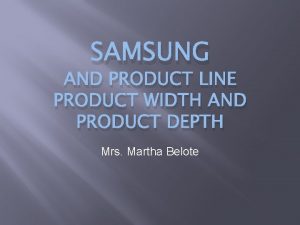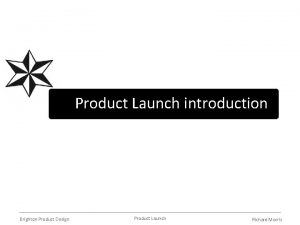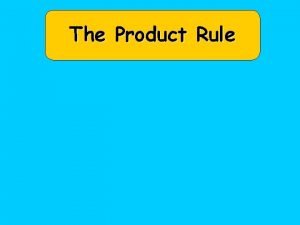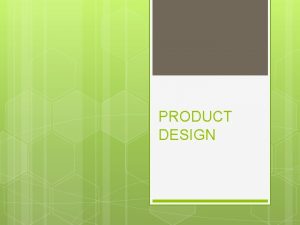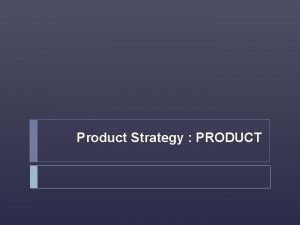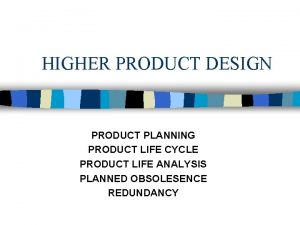Product Management What is a Product u A







































- Slides: 39

Product Management

What is a Product? u. A PRODUCT is anything that can be offered to a market for attention, acquisition, use, or consumption and that might satisfy a want or need. u Includes: – – – – – Physical Objects Services Experiences Events Persons Places Organizations Ideas Combinations of the above

A Product Manager’s Potential Interactions Agency media department Suppliers Manuf. & Distr. Trade Suppliers Advertising Agency R&D Media Company media department Media sales reps Premium suppliers Premium screening Promotion Store testing Service Sampling Couponing Packaging Product Manager Legal Purchasing Fiscal Research Suppliers Publicity Marketing Research Sales Trade Designers Researchers Suppliers

Levels of Product

Product Classifications: Consumer Convenience Products Shopping Products Ø Buy frequently & immediately Ø Buy less frequently Specialty Products Unsought Products Ø Special purchase efforts Ø New innovations Ø Low priced Ø Mass advertising Ø Many purchase locations i. e Candy, newspapers Ø High price Ø Unique characteristics Ø Brand identification Ø Few purchase locations i. e Lamborghini, Rolex Ø Higher price Ø Fewer purchase locations Ø Comparison shop i. e Clothing, cars, appliances Ø Products consumers don’t want to think about Ø Require much advertising & personal selling i. e Life insurance, blood donation

Product Classifications: Industrial Materials and Parts Raw materials, manufactured materials, and parts Capital Items Industrial products that aid in buyer’s production or operations Supplies and Services Operating supplies, repair/ maintenance items

Individual Product Decisions

The Multiattribute Model u The multiattribute model of decision making is composed of four parts: – The products or alternatives in a product category are assumed to be collections of attributes – Each customer is assumed to have a perception about how much of each attribute the alternatives in a product category contain – Each customer is assumed to place an importance value or weight on obtaining each attribute when making a choice in the category – Customer are assumed to combine the attribute and importance weight information using some process, or rule, to develop their most preferred option in the product category

Types of Attributes u Features u Benefits u Functions u Theoretically, the three basic types of attributes occur in sequence; a feature permits a certain function, which in turn leads to a benefit

Combining the Information u A compensatory rule: – Simply multiplies each attribute importance weighted by the attribute value and sums these terms for each person and product (all attributes are considered and weaknesses in one can be compensated for by strength of another) u A lexicographic rule: – First compares all products on the most important characteristic alone and eliminates those which are not at the top u A conjunctive rule: – Assumes the customer set minimum cutoffs on each dimension and rejects a product if it has any characteristic below the cutoff

Trade-Off (Conjoint) Analysis u u Conjoint analysis is a technique that is more commonly used in concept evaluation It is based on the simple premise that consumers evaluate the value or utility of a product/service/idea (real or hypothetical) by combining the separate amounts of utility provided by each attribute The researcher first constructs a set of real or hypothetical products or services by combining the selected levels of each attribute These hypothetical products are then presented to respondents who provide only their overall evaluations

Example Thickness Regular Regular Thick Thick Extra-Thick Extra-Thick Spiciness Mild Medium-Hot Extra-Hot Mild Medium-Hot Extra-Hot Color Red Green Red Green Red Green Actual Ranking 4 3 10 6 15 16 2 1 8 5 13 11 7 9 14 12 17 18 Estimated Ranking 4 3 10 8 16 15 2 1 6 5 13 11 7 9 14 12 18 17

Conjoint Analysis Output Color Spiciness Thickness 2 1 Utility 0 -11 -2 Regular. 161 Mild Medium-Hot Ex-Hot 1. 667. 105 -1. 774 Thick Ex-Thick. 913 -1. 074 Red -. 161 Green. 161 Importance of Attributes 0 Spiciness Thickness Color 20 40 60 59. 8% 34. 6% 5. 6% 80 100%

SKU Management u u u Managing stock-keeping units (SKUs) is important for companies that manufacture consumer packaged goods and for retailers Product addition vs. product deletion For most consumer packaged goods, SKUs are described in terms of a set of physical attributes that uniquely identifies each item (e. g. , Using six different SKU attributes (brand, package size, package type, product form, formula, and flavor) to portray the toothpaste market). SKU attributes must be recognizable to consumers SKU attributes must be objective (no ambiguity about the level of any attribute) The number of levels per attribute tend to be modest, usually no more than four (the biggest exception is flavor)

Design u u u The synthesis of technology and human needs into manufacturable products It can be the basis for a total company strategy It can be an afterthought where industrial designers are asked to “pretty up” a product that is about ready to be manufactured It blends form and function, quality and style, art and engineering A good design is aesthetically pleasing, easy to make and use, reliable, economical to operate and service, and fit recycling standards

Mass Customization u u Mass customization is the new frontier in business competition for both manufacturing and service industries At its core is a tremendous increase in variety and customization without a corresponding increase in costs At its limit, it is the mass production of individually customized goods and services At its best, it provides strategic advantage and economic value

The New Frontier in Business Competition u u u Created processes for low-cost, volume production of great variety, and even for individually customized goods and services The most prototypical mature mass production industry, automobiles, is a hotbed of innovation and variety Henry Ford’s dictum, “You can have any color car you want as long as it’s black, ” is long gone Providing tremendous variety, and individual customization, at prices comparable to standard goods and services--and often better Travel agency; Story book; Game

What Is Happening? u u u u u Automobile Industry Information Technology Industry Telecommunication Industry Personal Care Industries Beverage Industries Breakfast Cereal Industry Fast-Food Restaurant Industry Insurance Industry Banking Industry

Mass Customization vs. Mass Production Focus Goal Efficiency through stability and control Developing, producing, marketing, and delivering goods and services at prices low enough that nearly everyone can afford them Key • Stable demand Features • Large, homogeneous markets • Low-cost, consistent quality, standardized goods and services • Long product development cycles • Long product life cycle Mass Customization Variety and customization through flexibility and quick responsiveness Developing, producing, marketing, and delivering affordable goods and services with enough variety and customization that nearly everyone finds exactly what they want • Fragmented demand • Heterogeneous niches • Low-cost, high-quality, customized goods and services • Short product development cycles • Short product life cycles

Mass-Customizing Products and Services u Customize services around standard products and services u Create customizable products and services u Provide point-of-delivery customization u Provide quick response throughout the value chain u Modularize components to customize end products and services

Customize Services Around Standardized Products and Services Development Production Marketing Delivery Deliver Customized Services as Well as Standardized Products or Services Market Customized Services with Standardized Products or Services Continue Producing Standardized Products or Services Continue Developing Standardized Products or Services

Create Customizable Products or Services Development Production Marketing Delivery Deliver Standardized (But Customizable) Products or Services Market Customizable Products or Services Product Standardized (But Customizable) Products or Services Develop Customizable Products or Services

Provide Point-of-Delivery Customization Pr od Production Marketing n Delivery Pr Development uc tio od n tio uc Produce and Deliver Customized Portion Deliver Standardized Portion Market Customized Products or Services Produce Standardized Portion of Products or Services Continue Developing Standardized Products or Services

Provide Quick Response throughout the Value Chain Delivery Marketing Production Development Reduce Delivery Cycle Times Reduce Selection and Order Processing Cycle Times Reduce Production Cycle Time Reduce Development Cycle Time

Modularize Components to Customize End Products and Services Development Production Marketing Delivery Deliver Customized Products or Services Market Customized Products or Services Produce Modularized Products or Services Develop Modularized Products or Services

Product Platform u. A platform is defined as the collection of assets that are shared by a set of products. u Develop differentiated products efficiently u Increase the flexibility of and responsiveness of the manufacturing processes u Take market share away from competitors u Achieve successful mass customization -- the manufacture of products in high volumes that are tailored to meet the needs of individual customers

The Examples u u The Auto industry: several individual models may share the same basic frame, suspension and transmission “A robust platform is the heart of a successful product family, serving as the foundation for a series of closely related products” The Sony Walkman (160 variations and four major technical innovations between 1980 and 1990) Johnson & Johnson (launched Acuvue disposable contact lenses in 1987)

Market Testing and the Other Testing Steps Product concept R&D prototype Production prototype Product used for national launch Marketing Plan Concept test Product use test Marketing components tests: Ad copy, pricing, and others Market test Target Positioning Price Promotion Distribution Packaging Service Plan Final plan for national launch

Use Tests u Alpha tests: end-users in real work environment u Beta tests: short-term use tests, at selected customer sites u Gamma testing: it designates the ideal product use test, where the item is put through its paces and thoroughly evaluated by the end user; to pass this test, the new item must solve whatever problem the customer had, no matter how long it takes

Ways to Test Product Use u Monadic: the new product alone – “Try this toothbrush, and tell me how you like it. ” u Paired comparison: The new product and another product--(1) the market leader or (2)one known to be the best or (3) the leader in the segment selected for the new product or (4) the one currently used by the testee – “Try these, and tell me how you like them, which one you prefer, etc. ” u Triangular: The new product and two of the others. A variation is to use to two variants of the new product and one of the others – “Try these, and tell me how you like them, which one you prefer, etc. ”

Blind Tests and Branded Tests u In blind tests, the new product is compared to existing products u The manufacturer’s identification is suppressed to measure the physical response without the confounding of brand attitudes u Honest perception requires brands u A good compromise is to do both, first a blind test, followed by a branded test

Gains and Losses from Product Use Testing Sales Without use testing With use testing Use Testing Troubles fixed Too late to recover Time

Levels of Market Competition u Inward – Product Form F Products typically pursue the same market segment, and their features have similar values – Product Category F What product managers naturally think of as the industry u Outward – Need Substitutable Product Categories F Generic Competition (Kotler) F Products or services fulfilling the same customer need F – Budget

Implications for Product Strategy u Competitive Level – Product form – Product category – Generic – Budget u Product Management Task – Convince customers that the brand is better than others in the product form – Convince customers that the product form is the best in the category – Convince customers that the product category is the best way to satisfy needs – Convince customers that the generic benefits are the most appropriate way to spend the discretionary budget

Product Mix (Product Assortment) pth e D e n i L Product(SKU) Product-Mix Width Product. Line Length Detergents Toothpaste Shampoo Ivory Tide Cheer Bold Era Gleem Crest Pert H&S Pantene Vidal Sassoon

Product Line Decisions Product Line Length Number of Items in the Product Line Stretching Filling Lengthen beyond current range Lengthen within current range Downward Both Directions Upward

Product Line Stretching

Two-Way Stretch Marriott added the Renaissance Hotels line to serve the upper end of the market and the Towne. Place Suites line to serve the moderate and lower ends.

Consideration Sets u u Consideration sets are often formed using very simple criteria Two generalizations will hold when consumers don’t have strong preferences within a category – Consumers tend to prefer an alternative if it fares well in comparison with others in the consideration set – Consumers do not like to choose an extreme option when trade-offs are involved; they generally prefer an option with intermediate attributes to one that is extreme u Compromise effect – When decisions are difficult to make because a consumer has trouble trading off one attribute for another, the inclusion of a “compromise” brand can help
 Top management and middle management
Top management and middle management Top management middle management first line management
Top management middle management first line management Top level management
Top level management Product life cycle kotler
Product life cycle kotler Produk gabungan
Produk gabungan Relationship between total average and marginal product
Relationship between total average and marginal product Product mix vs marketing mix
Product mix vs marketing mix Core product actual product
Core product actual product Dot vs cross product
Dot vs cross product Target market feasibility analysis
Target market feasibility analysis Product mix vs product line
Product mix vs product line Contoh soal dot product dan cross product
Contoh soal dot product dan cross product Core actual augmented
Core actual augmented Dogld
Dogld Hasil kali silang cross product
Hasil kali silang cross product What is gnp and gdp
What is gnp and gdp Agile product cost management
Agile product cost management Biggest mistakes product management
Biggest mistakes product management Svpg product strategy
Svpg product strategy Product management organization structure
Product management organization structure Ibm product lifecycle
Ibm product lifecycle Oracle innovation management cloud
Oracle innovation management cloud Mrd product management
Mrd product management Product line management example
Product line management example Product management introduction
Product management introduction Financial analysis of product management
Financial analysis of product management Product design and process selection
Product design and process selection Product design and process selection
Product design and process selection Product management and global brands
Product management and global brands Ienable plm
Ienable plm Cim product management
Cim product management What is product service management
What is product service management Product and service design
Product and service design Product management 101
Product management 101 Changes affecting product management
Changes affecting product management Product selection in operations management
Product selection in operations management Product mix decisions in management accounting
Product mix decisions in management accounting Product management systems
Product management systems Process strategy operations management
Process strategy operations management Abrasion peeling
Abrasion peeling




